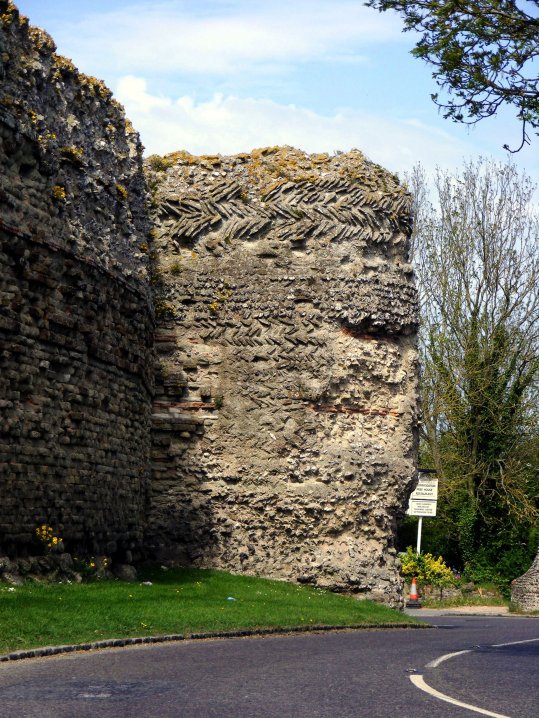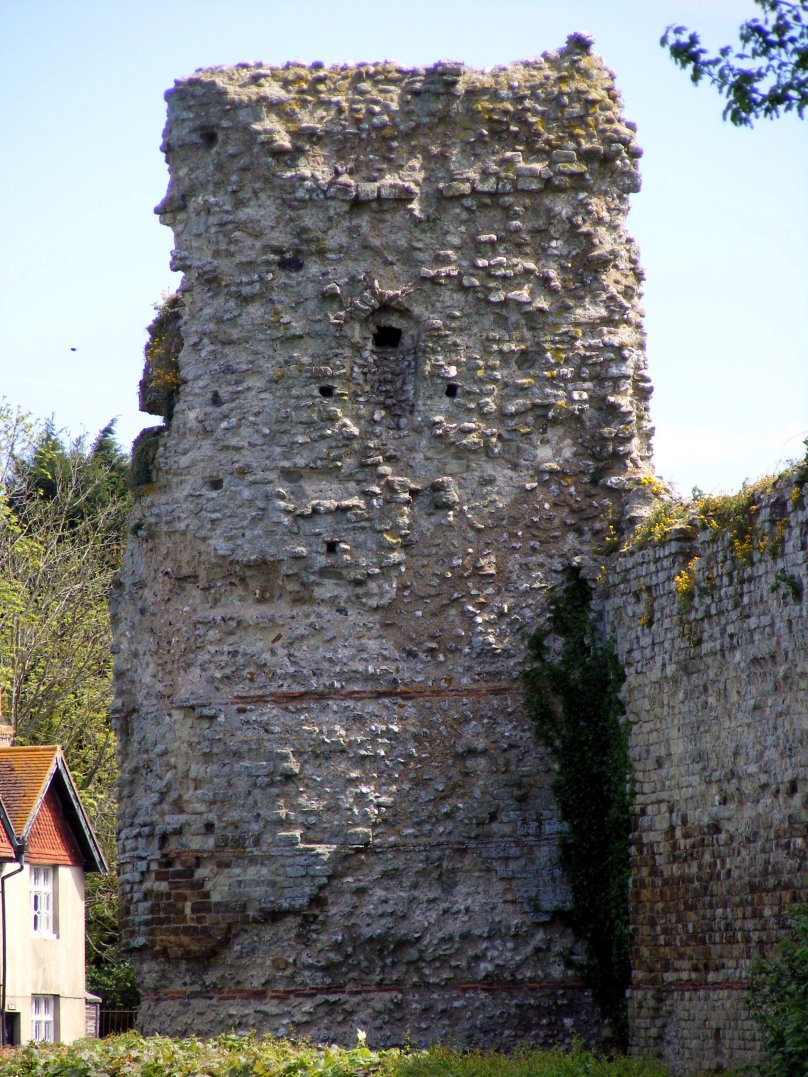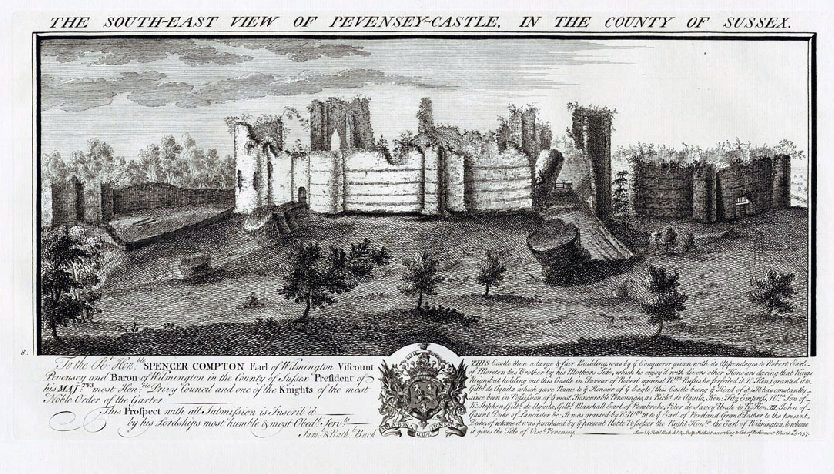Pevensey

Sited on the south coast of England, the remains of Anderita
Saxon Shore fort, has long been an important military site.
Recent archaeological work has suggested a building date for the first
fort in the 290s. This would suggest that it was founded by
Carausius (d.293) as part of his separatist empire of Britain from
286-296. Such a date could well suggest that other Saxon Shore
Forts are also earlier. Alternatively it may be why Pevensey fort
is laid out in such an idiosyncratic manner, rather than the standard
rectangular form seen at Portchester or Cardiff.
The Notitia Dignitatum of 375-425 mentions the following Saxon Shore
forts, Brancaster (Branodunum), Burgh Castle (Gariannonum), Bradwell on
Sea (Othona), Reculver (Regulbium), Richbrough (Rutupiae), Dover (Dubris), Lympne (Portus Lemanis), Pevensey (Anderitum) and Portchester
(Portus Adurni). Other sites not mentioned but apparently part of
the defensive limes were Walton Castle, Caister on Sea, Carisbrooke
castle, Bitterne (Clausentum in Southampton), Skegness, Lancaster and
in Wales, Caerwent, Cardiff and Caer Gybi.
 The
Roman fort
was later converted into a Norman enclosure castle, a sixteenth century
gun
emplacement and finally was fortified again in World War II.
Previously the fort had been dated to the first half of the fourth
century when it
was suggested as the last Saxon Shore fort to be built in
Britain. Again this shows the dangerous of being too certain of
the dating of any of these impressive structures. Similalry the
employment of herringbone masonry at the site overlies Roman work and
may therefore be from the pre Norman Conquest era.
The
Roman fort
was later converted into a Norman enclosure castle, a sixteenth century
gun
emplacement and finally was fortified again in World War II.
Previously the fort had been dated to the first half of the fourth
century when it
was suggested as the last Saxon Shore fort to be built in
Britain. Again this shows the dangerous of being too certain of
the dating of any of these impressive structures. Similalry the
employment of herringbone masonry at the site overlies Roman work and
may therefore be from the pre Norman Conquest era.
It is enclosed by a massive defensive wall which was strengthened
by irregularly-spaced, externally projecting semicircular bastions of
which ten survive of the original 15 or so. The defensive wall
has a flint and sandstone rubble core faced by coursed greensand and
ironstone blocks, interspersed with red tile bonding courses. The
whole is up to 12' thick and survives to a height of up to 26'.
The wall was originally topped by a wallwalk and parapet.
 Anderita is always said to
have been abandoned by the latter half of the fourth century. This
is rather contradicted by the Anglo-Saxon Chronicle recording a
massacre of Britons here by the invading Saxons in AD 491 when
King Aelle is said to have butchered the defenders. The fort may have remained a Saxon stronghold, for in the seventh century Ravenna Cosmography it appears as Anderelio Nuba which would appear to be a corruption for Anderitum Nova. The fact it was New (Nova) may indicate a certain amount of rebuilding - maybe this was the herringbone work found in the Roman walls.
Anderita is always said to
have been abandoned by the latter half of the fourth century. This
is rather contradicted by the Anglo-Saxon Chronicle recording a
massacre of Britons here by the invading Saxons in AD 491 when
King Aelle is said to have butchered the defenders. The fort may have remained a Saxon stronghold, for in the seventh century Ravenna Cosmography it appears as Anderelio Nuba which would appear to be a corruption for Anderitum Nova. The fact it was New (Nova) may indicate a certain amount of rebuilding - maybe this was the herringbone work found in the Roman walls.
In October 1066 William the Conqueror built a castle
within the old Roman enclosure and gave it to his half-brother, Count Robert of
Mortain. Count Robert also went on to collect Berkhamsted and Launceston castles from the Crown. It
is well-known that William landed at Pevensey in 1066, but it is less
well-known that the Norman army are believed to have made use of the
Roman fort as one of their first armed camps when they reforteneeified it
with a ditch. This is possibly the site of the ditch around the
current castle within the fort. The early stone castle consisted
of a rectangular tower-keep roughly 55' by 30'
internally. To this a larger rectangular building was later added
to the SE as well as bastions to the tower-keep. The rectangular
masonry enclosure was added later, supposedly soon after 1190 when the
gatehouse was said to have been begun. Three D shaped towers
completed the enceinte. Near the well are a pile of medieval
stone catapult balls, a selection of those recovered from excavation of
the ditch. Possibly these are survivors of the four sieges of the
castle. Pevensey was besieged in 1088 by King William Rufus,
after Count Robert rebelled against his nephew. It is possible
that Robert never regained his castle after this. In 1104
Robert's son rebelled on not receiving what he thought was a fair share
of the family inheritance. He later fell into Henry I's hands at the battle of Tinchenbrai in 1106. These acts spilt up the tenurial history of the three castles of Pevensey, Launceston and Berkhamsted.
Pevensey was initially held by the Crown. The rectangular keep was standing
by September 1129 when it was recorded that 16s had been paid to the
watchmen of Pevensey keep (Turris de Penuesel).
Sometime after this it passed to the Clare family with the
result that Earl Gilbert Clare of Hertford (d.1152) was besieged in the
castle during 1146/7 before being forced to vacate the
fortress and retire to the family fortresses in Wales, namely Goodrich, Pembroke and Chepstow. Pevensey
castle then returned to royal hands apart from a short while from 1153
to 1157 when it was held by Count William of Blois (d.1159), the son of
King Stephen. Much rebuilding
was undertaken by King Richard I (1189-99) which may have included the
building of the great twin towered gatehouse.
The towers and inner curtain are traditionally dated to the
1220s to 1240s, in which case they should be examined with the
Trilateral in mind. In the early summer of 1264 the castle suffered another siege
when the defeated Royalists from the battle of Lewes
were forced to either surrender or abjure the country. The final siege was a lack lustre affair in 1399.
By 1300, the sea had gradually begun to recede from around the castle
and its military importance declined as a result. By 1500 the
castle was in ruins. However, the threat of the Spanish Armada
led to two demi-culverins, or heavy guns, being housed within the Roman
fort in 1587. At the outbreak of World War II, the castle was
refortified in May 1940 with machine gun emplacements to protect an
observation and command post.
For more detailed descriptions of the castle see Sussex Arch Soc and Collections:
Why not join me at Pevensey and other British castles this October? Please see the information on tours at Scholarly Sojourns.
Copyright©2010
Paul Martin Remfry


 The
Roman fort
was later converted into a Norman enclosure castle, a sixteenth century
gun
emplacement and finally was fortified again in World War II.
Previously the fort had been dated to the first half of the fourth
century when it
was suggested as the last Saxon Shore fort to be built in
Britain. Again this shows the dangerous of being too certain of
the dating of any of these impressive structures. Similalry the
employment of herringbone masonry at the site overlies Roman work and
may therefore be from the pre Norman Conquest era.
The
Roman fort
was later converted into a Norman enclosure castle, a sixteenth century
gun
emplacement and finally was fortified again in World War II.
Previously the fort had been dated to the first half of the fourth
century when it
was suggested as the last Saxon Shore fort to be built in
Britain. Again this shows the dangerous of being too certain of
the dating of any of these impressive structures. Similalry the
employment of herringbone masonry at the site overlies Roman work and
may therefore be from the pre Norman Conquest era. Anderita is always said to
have been abandoned by the latter half of the fourth century. This
is rather contradicted by the Anglo-Saxon Chronicle recording a
massacre of Britons here by the invading Saxons in AD 491 when
King Aelle is said to have butchered the defenders. The fort may have remained a Saxon stronghold, for in the seventh century Ravenna Cosmography it appears as Anderelio Nuba which would appear to be a corruption for Anderitum Nova. The fact it was New (Nova) may indicate a certain amount of rebuilding - maybe this was the herringbone work found in the Roman walls.
Anderita is always said to
have been abandoned by the latter half of the fourth century. This
is rather contradicted by the Anglo-Saxon Chronicle recording a
massacre of Britons here by the invading Saxons in AD 491 when
King Aelle is said to have butchered the defenders. The fort may have remained a Saxon stronghold, for in the seventh century Ravenna Cosmography it appears as Anderelio Nuba which would appear to be a corruption for Anderitum Nova. The fact it was New (Nova) may indicate a certain amount of rebuilding - maybe this was the herringbone work found in the Roman walls.